V-ing作表语-定语-宾补
- 格式:ppt
- 大小:1.36 MB
- 文档页数:7
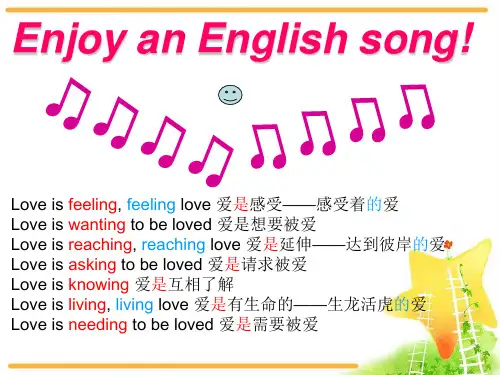
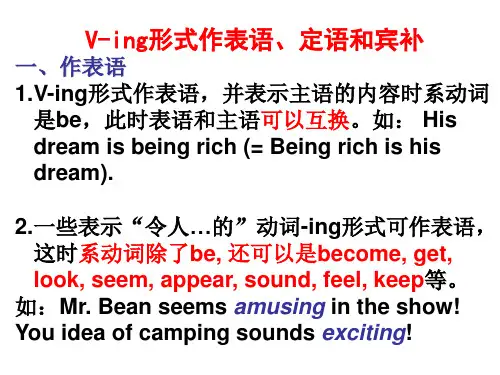



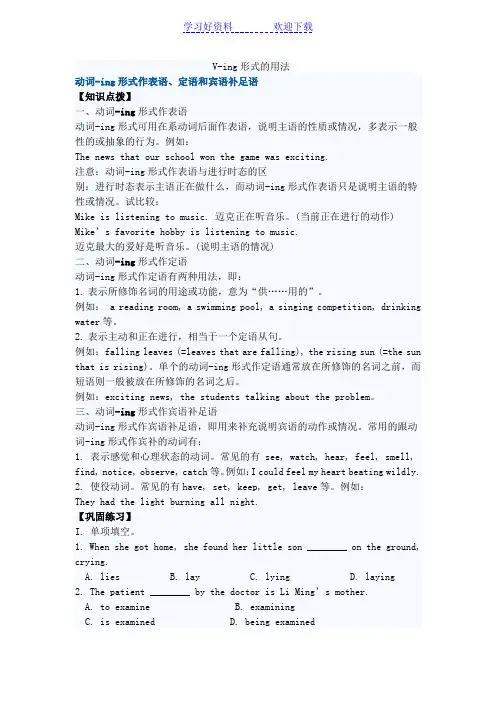
V-ing形式的用法动词-ing形式作表语、定语和宾语补足语【知识点拨】一、动词-ing形式作表语动词-ing形式可用在系动词后面作表语,说明主语的性质或情况,多表示一般性的或抽象的行为。
例如:The news that our school won the game was exciting.注意:动词-ing形式作表语与进行时态的区别:进行时态表示主语正在做什么,而动词-ing形式作表语只是说明主语的特性或情况。
试比较:Mike is listening to music. 迈克正在听音乐。
(当前正在进行的动作) Mike’s favorite hobby is listening to music.迈克最大的爱好是听音乐。
(说明主语的情况)二、动词-ing形式作定语动词-ing形式作定语有两种用法,即:1.表示所修饰名词的用途或功能,意为“供……用的”。
例如: a reading room, a swimming pool, a singing competition, drinking water等。
2.表示主动和正在进行,相当于一个定语从句。
例如:falling leaves (=leaves that are falling), the rising sun (=the sun that is rising)。
单个的动词-ing形式作定语通常放在所修饰的名词之前,而短语则一般被放在所修饰的名词之后。
例如:exciting news, the students talking about the problem。
三、动词-ing形式作宾语补足语动词-ing形式作宾语补足语,即用来补充说明宾语的动作或情况。
常用的跟动词-ing形式作宾补的动词有:1. 表示感觉和心理状态的动词。
常见的有 see, watch, hear, feel, smell, find, notice, observe, catch等。
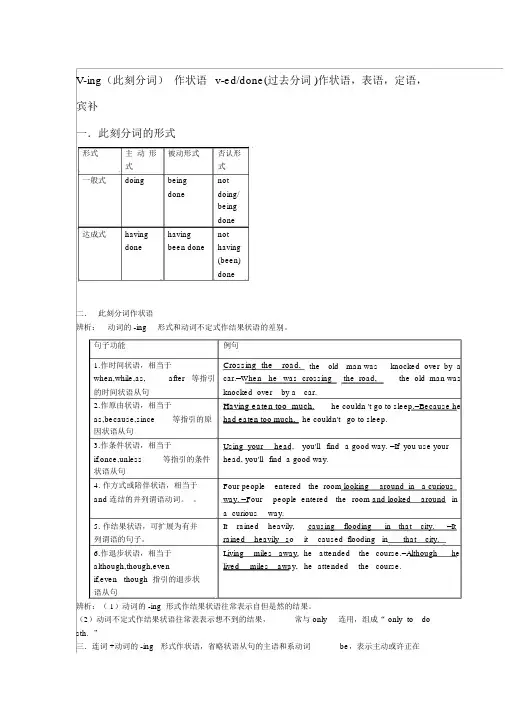
V-ing(此刻分词)作状语v-ed/done(过去分词 )作状语,表语,定语,宾补一.此刻分词的形式形式主动形被动形式否认形式式一般式doing being notdone doing/beingdone达成式having having notdone been done having(been)done二.此刻分词作状语辨析:动词的 -ing形式和动词不定式作结果状语的差别。
句子功能例句1.作时间状语,相当于Crossing the road,the old man was knocked over by awhen,while,as,after 等指引car.=When he was crossing the road,the old man was 的时间状语从句knocked over by a car.2.作原由状语,相当于Having eaten too much,he couldn 't go to sleep.=Because heas,because,since等指引的原had eaten too much,he couldn't go to sleep.因状语从句3.作条件状语,相当于Using your head,you'll find a good way. =If you use yourif,once,unless等指引的条件head, you'll find a good way.状语从句4. 作方式或陪伴状语,相当于Four people entered the room looking around in a curiousand 连结的并列谓语动词。
way. =Four people entered the room and looked around ina curious way.5. 作结果状语,可扩展为有并It rained heavily,causing flooding in that city.=It列谓语的句子。

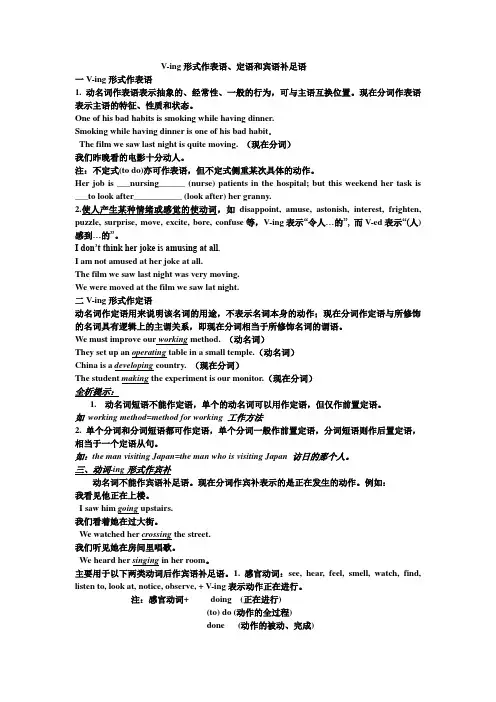
V-ing形式作表语、定语和宾语补足语一V-ing形式作表语1. 动名词作表语表示抽象的、经常性、一般的行为,可与主语互换位置。
现在分词作表语表示主语的特征、性质和状态。
One of his bad habits is smoking while having dinner.Smoking while having dinner is one of his bad habit.The film we saw last night is quite moving. (现在分词)我们昨晚看的电影十分动人。
注:不定式(to do)亦可作表语,但不定式侧重某次具体的动作。
Her job is ___nursing______ (nurse) patients in the hospital; but this weekend her task is ___to look after___________ (look after) her granny.2.使人产生某种情绪或感觉的使动词,如disappoint, amuse, astonish, interest, frighten, puzzle, surprise, move, excite, bore, confuse等,V-ing表示“令人…的”, 而V-ed表示“(人)感到…的”。
I don’t think her joke is amusing at all.I am not amused at her joke at all.The film we saw last night was very moving.We were moved at the film we saw lat night.二V-ing形式作定语动名词作定语用来说明该名词的用途,不表示名词本身的动作;现在分词作定语与所修饰的名词具有逻辑上的主谓关系,即现在分词相当于所修饰名词的谓语。
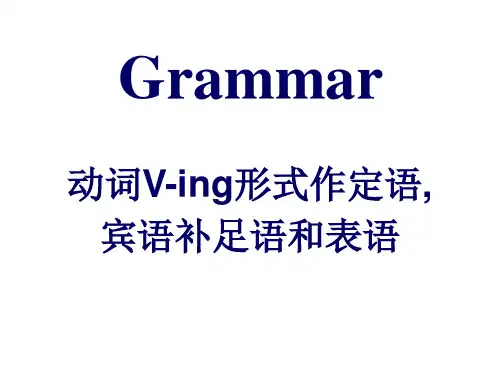
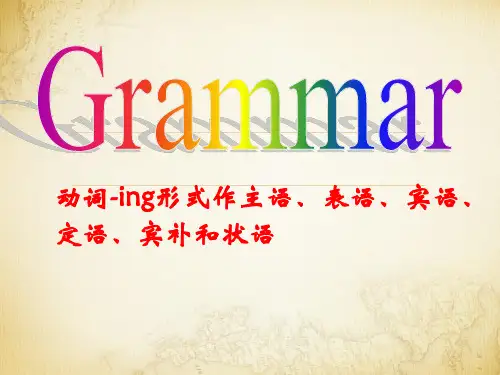
动词的ing形式作表语,定语,宾补和状语一、动词-ing形式作表语1. 表示主语的内容,可以转换到句首作主语Her job is keeping the lecture hall as clean as possible. (= keeping the lecture hall as clean as possible is her job)她的工作是尽量使报告厅保持干净。
2. 表示主语具有的特征、性质和状态(动词ing 相当一个形容词)The problem is quite puzzling.这个问题很令困惑。
3.常用来作表语的现在分词有astonishing, amusing, confusing, disappointing, boring, encouraging, inspiring, moving, tiring, interesting, surprising等。
全析提示:动词-ing形式作表语时,其逻辑主语往往是句子中的主语,但用作表语的-ing形式也可带有自己的逻辑主语。
What worries me most is her staying too late every night. (staying too late every night的逻辑主语是her)二、动词-ing形式作定语1 单个的动词-ing形式可以作前置定语,一般具有两种含义。
①说明被修饰名词的用途和性能。
a reading room = a room which is used for reading 阅览室running shoes =shoes for running 跑鞋a working method =a method for working 工作方法②表示所修饰的人或物的动作或状态,在意思上接近一个定语从句,可以表示正在进行的动作,也可表示经常性动作或当时的状态。
developing countries = countries that are developing发展中国家an ordinary-looking house = a house that looks ordinary看起来很普通的房子a puzzling problem = a problem that puzzles somebody困扰人的问题2 作定语的动词-ing形式如是一个短语,则应放在被修饰词的后面,做后置定语,相当于一个定语从句。
第九讲动词-ing形式作表语.定语和宾补姓名:学校:年级:【学习目标】掌握ing形式在句中作表语,定语和宾补。
学会区分ing形式表主动,ed形式表被动。
【知识要点】1.v.-ing形式作定语时的表达含义:v.-ing形式作定语时,表示动作正在进行或与谓语动词所表示的动作几乎同时发生,或表示某个经常的动作或状态eg:a flying bird = a bird that is flying 在飞的鸟儿a running horse = a horse is running 在奔跑的马a sleeping child = a child who is sleeping 在睡觉的孩子a walking girl = a girl who is walking 在散步的女孩v.-ing 形式包括现在分词和动名词,它们的形式相同,都可作定语,但两者之间是有差别的。
现在分词和动名词,它们的形式相同,都可作定语,但两者之间是有差别的。
现在分词作定语时,被修饰的词和它之间有一种逻辑上的主谓关系,即被修饰的词执行现在分词所表示的这个动作,相当于一个定语从句。
而动名词作定语时,与被修饰的词之间没有这种关系,它仅表示一种用途,作“供作…..,”相当于一个for 介词短语。
a sleeping car 小卧车(动名词作定语,意为a car for sleeping)the rising sun 正在升起的太阳(现在分词作定语,意为the sun which is rising)2.V-ing 形式作定语时,可分为两种:一种仍有动词性质,如果是单个的或仅带有一个副词的v.-ing形式作定语时,常常用于所修饰的名词之前;v.-ing短语作定语时,放在被修饰的名词之后。
The man standing at the window is our teacher .Water existing in the air is called vapor.另一种是已经,已无动词性质,通常只置于所修饰的名词之前,表示它所修饰的名词的目的,用途或场合。